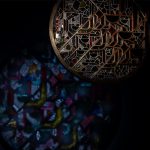Organized by Saudi Arabia’s Ministry of Culture, Scripts and Calligraphy is a temporary exhibition held every two years since 2021. The first edition, titled Scripts and Calligraphy: A Timeless Journey and held at the National Museum of Saudi Arabia in Riyadh, presented the origins of the Arabic script and the development of the art of calligraphy. It paid tribute to Saudi and international master calligraphers, contemporary artists, and designers, and shed light on the artistic relationship between calligraphy and artificial intelligence, thus demonstrating the timelessness of Arabic calligraphy and its endless journey towards the future of art.
The second edition, titled the Scripts and Calligraphy: Paths to the Soul exhibition, inaugurated at Old Irqah Hospital, Riyadh on June 11, 2023, explores the spiritual dimension of calligraphy in the Arab-Muslim civilization. Designed by acclaimed architects and scenographers Jean-Paul Boulanger (Pylône), Margo Renisio, and Tang Tu (Ideaa3), the exhibition is divided into four complementary themes: Light, Letter, Space, and Poetry. The sections shed light on the spirituality that infuses both the reflection and techniques of the calligraphers, contemporary designers and artists, and the emotion that Arabic calligraphy arouses in those who read it and contemplate it. The notions of light, letter, space, and poetry embody universal and spiritual values that frame the works on display and group them together to spark a potent and thought-provoking dialogue. Throughout the exhibition, Arabic script and calligraphy play a central role as the binding agent of disparate objects, from different time periods and of diverse nature.
For this edition of the exhibition, the Ministry of Culture has commissioned local, regional, and international master calligraphers as well as artists and designers to produce a significant collection of classical and contemporary artworks curated thematically supervised and directed by the exhibition Steering Committee members: Dr. Huda Smitshuijzen AbiFarès, Founder and Director of the Khatt Foundation, Amsterdam; Dr. Lotfi Abdeljaouad, Head of research at the National Heritage Institute, Tunis; Eric Delpont, Islamic Art specialist and director of the Museum of the Institut du monde Arabe, Paris; Nuria Garcia Masip, classically trained calligrapher; Dr. Issa Makhlouf, writer and poet; Nasser Al Maymoun, classically trained calligrapher; and Dr. Haytham Nawar, Associate Professor of Design, Department of the Arts at the American University in Cairo.
Thirty-four calligraphers from 11 countries participate in the exhibition: Lama Abdulrahman, Ibrahim Al Arafi, Jamal Al Kebasi, Nasser Al Maymoun, Majid Alyousef, Zaki Al Hashimi, Obaid AlNofaey, Nabeel Bukhari, Bayan Barboud, Abdulrahman Elshahed, Ahmad Jeddawi, Ahmed Fares Rezq, the late Mohammad Salem Bajnaid (Kingdom of Saudi Arabia); Khodeir El-Borsaidy, Hani El-Tawel, Hazem El Mestikawy, the late Omar El-Nagdi, Sameh Ismael, the late Sayyid Ibrahim, Mohamad Gaber, Haytham Zakaria (Tunisia); Ibrahim Batchelder (United States of America); Pablo Casado, Nuria Garcia Masip (Spain); Maryam Norouzi, the late Mustafa Rakim (Turkey); Ayman Hassan (Syria); Amor Jomni, Khaled Ben Slimane (Tunisia); Jassim Miraj Al-Failakawi (Kuwait); Samir Sayegh (Lebanon); the late Ahmad Shibrain, the late Osman Waqialla (Sudan); Mohanad Qaisi, Ihab Thabet, the late Rafa AlNasiri (Jordan).
Nineteen contemporary artists and designers from 12 countries have also contributed: Faig Ahmed (Azerbaijan); Lara Assouad (Canada); Yusef Alahmad, Nasser Al Salem, Doa Bugis and Sarah Al Abdali (Kingdom of Saudi Arabia); Nasser Al Aswadi (Yemen); Sara Alharbali (United Arab Emirates); Farah Behbehani (Kuwait); Nada Debs, Noor Saab, the late Etel Adnan, the late Kamal Boullata(Lebanon); Azza Fahmy, Randa Fahmy (Egypt); Susan Hefuna (Germany/Egypt); Yazid Kheloufi (Algeria); Hala Kaiksow (Bahrain); Timo Nasseri (Germany); Sadek Rahim (Algeria); Sara Ouhaddou (Morocco)
In addition to the commissioned artworks, the collection showcases Islamic art artworks and rare manuscripts from the permanent collection of the Ministry of Culture as well as others lent from the museum of the Arab World Institute in Paris and the National Heritage Institute in Tunis.
Press release from Saudi Ministry of Culture



